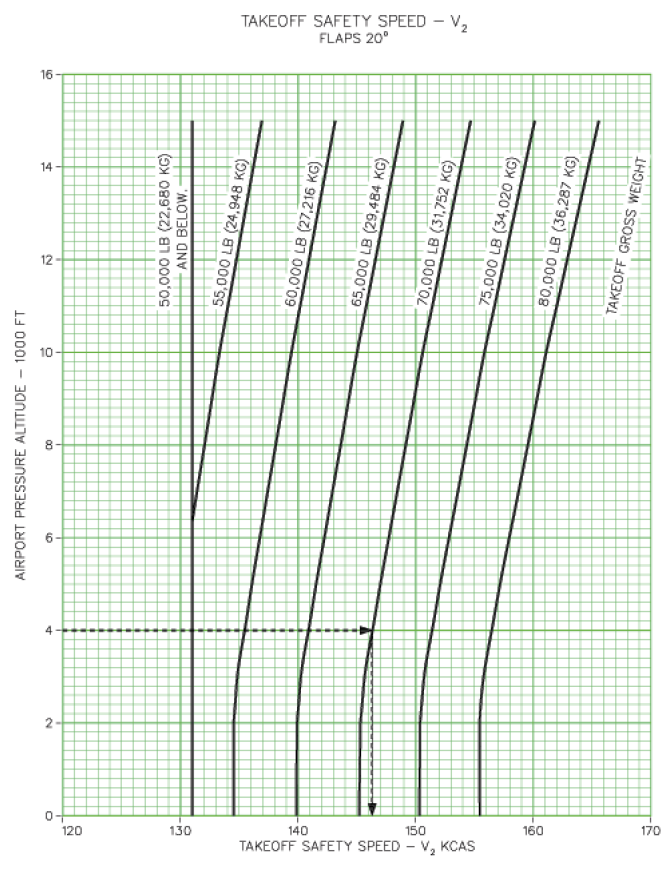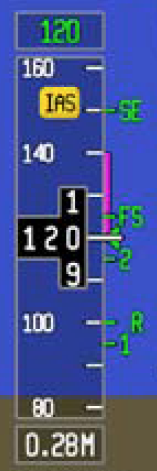V2 Safety Speed is aptly named: it gives you a minimum climb rate with an engine out with a margin of safety over stall and controllability speeds. You can even maneuver, though perhaps while sacrificing the climb.
— James Albright

Updated:
2020-02-12
Once you've made the decision to takeoff, V2 is your most important speed. In a Gulfstream PlaneView aircraft, keeping your speed between the "2" and the target triangle will keep you flying.

1
Regulatory
Definition
V2 means takeoff safety speed.
Source: 14 CFR 1.2
Certification
(b) V2MIN, in terms of calibrated airspeed, may not be less than—
(1) 1.13 VSR for—
(i) Two-engine and three-engine turbopropeller and reciprocating engine powered airplanes; and
(ii) Turbojet powered airplanes without provisions for obtaining a significant reduction in the one-engine-inoperative power-on stall speed;
(2) 1.08 VSR for—
(i) Turbopropeller and reciprocating engine powered airplanes with more than three engines; and
(ii) Turbojet powered airplanes with provisions for obtaining a significant reduction in the one-engine-inoperative power-on stall speed; and
(3) 1.10 times VMC established under § 25.149.
(c) V2, in terms of calibrated airspeed, must be selected by the applicant to provide at least the gradient of climb required by § 25.121(b) but may not be less than—
(1) V2MIN;
(2) VR plus the speed increment attained (in accordance with § 25.111(c)(2)) before reaching a height of 35 feet above the takeoff surface; and
(3) A speed that provides the maneuvering capability specified in § 25.143(h).
Source: 14 CFR 25.107
The airplane must reach V2 before it is 35 feet above the takeoff surface and must continue at a speed as close as practical to, but not less than V2, until it is 400 feet above the takeoff surface.
Source: 14 CFR 25.111 (c)(2)
(a) The takeoff flight path shall be considered to begin 35 feet above the takeoff surface at the end of the takeoff distance determined in accordance with § 25.113(a) or (b), as appropriate for the runway surface condition.
(b)The net takeoff flight path data must be determined so that they represent the actual takeoff flight paths (determined in accordance with § 25.111 and with paragraph (a) of this section) reduced at each point by a gradient of climb equal to—
(1) 0.8 percent for two-engine airplanes;
(2) 0.9 percent for three-engine airplanes; and
(3) 1.0 percent for four-engine airplanes.
Source: 14 CFR 25.115
Takeoff; landing gear retracted. In the takeoff configuration existing at the point of the flight path at which the landing gear is fully retracted, and in the configuration used in § 25.111 but without ground effect:
(1) The steady gradient of climb may not be less than 2.4 percent for two-engine airplanes, 2.7 percent for three-engine airplanes, and 3.0 percent for four-engine airplanes, at V2 with:
(i) The critical engine inoperative, the remaining engines at the takeoff power or thrust available at the time the landing gear is fully retracted, determined under § 25.111, unless there is a more critical power operating condition existing later along the flight path but before the point where the airplane reaches a height of 400 feet above the takeoff surface; and
(ii) The weight equal to the weight existing when the airplane's landing gear is fully retracted, determined under § 25.111.
(2) The requirements of paragraph (b)(1) of this section must be met:
(i) In non-icing conditions; and
(ii) In icing conditions with the takeoff ice accretion defined in appendix C, if in the configuration of § 25.121(b) with the takeoff ice accretion:
(A) The stall speed at maximum takeoff weight exceeds that in non-icing conditions by more than the greater of 3 knots CAS or 3 percent of VSR; or
(B) The degradation of the gradient of climb determined in accordance with § 25.121(b) is greater than one-half of the applicable actual-to-net takeoff flight path gradient reduction defined in § 25.115(b).
Source: 14 CFR 25.121 (b)
The maneuvering capabilities in a constant speed coordinated turn at forward center of gravity, as specified in the following table, must be free of stall warning or other characteristics that might interfere with normal maneuvering:
| Configuration | Speed | Maneuvering bank angle in a coordinated turn | Thrust/Power setting |
|---|---|---|---|
| Takeoff | V2 | 30° | Asymmetric WAT-Limited.1 |
| Takeoff | 2V2 + XX | 40° | All-engines-operating-climb.3 |
| En route | VFTO | 40° | Asymmetric WAT-Limited.1 |
| Landing | VREF | 40° | Symmetric for -3° flight path angle. |
1 A combination of weight, altitude, and temperature (WAT) such that the thrust or power setting produces the minimum climb gradient specified in § 25.121 for the flight condition.
2 Airspeed approved for all-engines-operating initial climb.
3 That thrust or power setting which, in the event of failure of the critical engine and without any crew action to adjust the thrust or power of the remaining engines, would result in the thrust or power specified for the takeoff condition at V2, or any lesser thrust or power setting that is used for all-engines-operating initial climb procedures.
Source: 14 CFR 25.143(h)
2
What it really means
V2 is, as the definition says, Takeoff Safety Speed. At V2:
- You will have a margin of safety above VSR Reference Stall Speed and VMC Minimum Control Speed.
- You will be able to climb with an engine out, gear retracted, flaps at their takeoff setting, and above ground effect by at least 2.4% (two engine aircraft), 2.7% (three engine aircraft), and 3.0% (four engine aircraft).
- You will be able maneuver in a 30° bank coordinated turn. (The regulation does not imply you can still climb while turning, however.)
3
Gulfstream example

V2 Flaps 20°, from G450 AFM, § 5.5-8.
V2, TAKEOFF SAFETY SPEED - the target speed to be attained at the 35 foot height following an engine failure.
Source: G-450 AFM § 5.1-3
What might be more instructive, however, is a comparison of typical VR speeds against V1 speeds, and VSR Reference Stall Speeds:
| GWT | V2 | V1 | VSR |
|---|---|---|---|
| 74,600 | 150 | 144 | 122 |
| 70,000 | 145 | 138 | 118 |
| 60,000 | 135 | 123 | 110 |
| 50,000 | 131 | 116 | 100 |
All of these are taken from sea level, 30°C, Flaps 20°.
References
(Source material)
14 CFR 1, Title 14: Aeronautics and Space, Definitions and Abbreviations, Federal Aviation Administration, Department of Transportation
14 CFR 25, Title 14: Aeronautics and Space, Airworthiness Standards: Transport Category Airplanes, Federal Aviation Administration, Department of Transportation
Gulfstream G450 Airplane Flight Manual, Revision 35, April 18, 2013
Please note: Gulfstream Aerospace Corporation has no affiliation or connection whatsoever with this website, and Gulfstream does not review, endorse, or approve any of the content included on the site. As a result, Gulfstream is not responsible or liable for your use of any materials or information obtained from this site.
